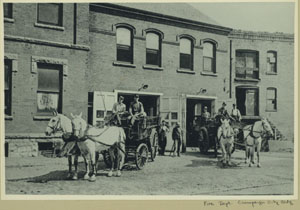American History Teachers' Collaborative Reflection Paper
Beth Koplinski
July 27, 2007
This
summer institute was one of the best workshops that I have attended. I enjoyed learning about so many
different things, but the one aspect that I continually enjoy listening about
is about primary documents.
I never realized until I started coming to these workshops that there
are so many documents one can use in the classroom to help reinforce topics and
standards. In the workshop this
week, we were given the choice to write a lesson plan or a reflective
paper. I have chosen to write a
reflective paper analyzing a primary document.
The
document that I have chosen is the one above. This is a picture of the Champaign Fire Department taken
around the year 1900. The photo was found at the Champaign County Historical
Museum. I chose this photo because
many members of my family are firefighters. My father was a volunteer fireman and is now the assistant fire
chief in his department, and my brother has chosen to be a fire fighter as his
profession. Growing up,
firefighting was always around me.
There was always the sound of the radio telling which department was
called for which fire, there were many Christmas parties at the fire house, and
lots of close friends were made through this external family. When I saw this picture, many memories
came back to me of pictures IÕve seen at home dealing with our local fire
department. It seemed fitting to
choose this picture to analyze.
As
I looked at this photo, the impression that I got was that they probably didnÕt
put out too many fires and were not able to get where they needed to be very
quickly. I gathered this
impression by looking at the people, the objects, and the activities that
seemed to be taking place. In the
photo, you see men, all of whom appear to be white, sitting at the front of the
wagon that are obviously the firemen; but you also see an old man with a cane,
a man with overalls on, and someone who looks like a business man on the back
of one of the wagons. I have to
wonder who they are and what their part of the picture is. Was one the chief and one the horse
caretaker? Were there standard
uniforms? They donÕt all appear to
be wearing the same attire. I also
see a set of beautiful white horses and 2 wagons with 4 wheels that carried
ladders on both sides. I donÕt see
much equipment. Where did they
carry the water? Was there any
other equipment in the wagon? What did they actually use to put out the
fires? By looking at the front
doors of the firehouse, it looks as though thereÕs only room for the two wagons
and IÕm not quite sure where the horses would be kept. Did the men stay there or was it
volunteer and the men would show up when needed? These are just a few of the many observations and questions
that I had about this photo. To
find the answers to these questions, I could research online, visit the
Champaign Co. Public Library Archives, and probably go to a firehouse for an
interview.
Our
summer institute dealt with World War II.
I know that this photo was from 1900, but listening to Mark Leff speak
about sacrifice on the U.S. Homefront and how women took over many male
positions and went to work, I had to ask myself about this type of job. Did women become firefighters, police
officers, and take over for doctors? A website that I found that could answer
this question for me was www.i-women.org. In the search box, type World War II
and several article choices should appear. Researching online, going to the library, and interviewing
women firefighters could provide me with more information about women in
firefighting over time.
In
third grade we discuss our community and city. This photo would be great for a compare/contrast
activity. They could use a Venn
Diagram to do this. By looking at
this photo from 1900 and one from today, students could tell about the
similarities of firefighting and also the differences. A conclusion statement at the bottom of
the Venn Diagram, would be an assessment that they were able to pick out the
similarities and differences from back then compared to today. This would also be a great historical
research paper for a student to tackle.
Students could do exactly what I did: use the NARA photo analysis worksheet for analysis, then do
another worksheet for a picture taken from a firehouse today in order to write
a compare/contrast paper. Perhaps
they would want to research some of the questions they come up with when they
analyze.
This
photo really made me think about the large changes that have taken place over
time. Due to World War II, our
lives have changed dramatically, just like the changes that have taken place in
the firefighting industry over time.
